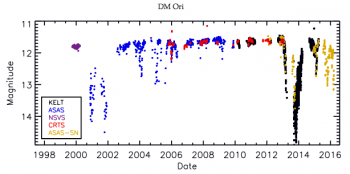
In some planet formation theories, protoplanets grow gravitationally within a young star's protoplanetary disk, a signature of which may be a localized disturbance in the disk's radial and/or vertical structure. Using time-series photometric observations by the Kilodegree Extremely Little Telescope South (KELT-South) project and the All-Sky Automated Survey for SuperNovae (ASAS-SN), combined with archival observations, we present the discovery of two extended dimming events of the young star, DM Ori. This young system faded by ∼1.5 mag from 2000 March to 2002 August and then again in 2013 January until 2014 September (depth ∼1.7 mag). We constrain the duration of the 2000-2002 dimming to be < 860 days, and the event in 2013-2014 to be < 585 days, separated by ∼12.5 years. A model of the spectral energy distribution (SED) indicates a large infrared excess consistent with an extensive circumstellar disk. Using basic kinematic arguments, we propose that DM Ori is likely being periodically occulted by a feature (possibly a warp or perturbation) in its circumstellar disk. In this scenario, the occulting feature is located >6 AU from the host star, moving at ∼14.6 km/s, and is ∼4.9 AU in width. This localized structure may indicate a disturbance such as may be caused by a protoplanet early in its formation.
Authors: Joseph E. Rodriguez, Keivan G. Stassun, Phillip Cargile, Benjamin J. Shappee, Robert J. Siverd, Joshua Pepper, Michael B. Lund, Christopher S. Kochanek, David James, Rudolf B. Kuhn, Thomas G. Beatty, B. Scott Gaudi, David A. Weintraub, Krzysztof Z. Stanek, Thomas W. S. Holoien, Jose L. Prieto, Daniel M. Feldman, Catherine C. Espaillat

